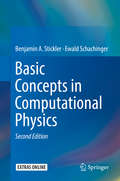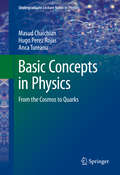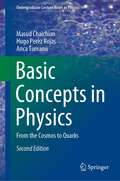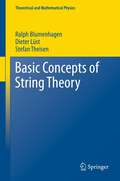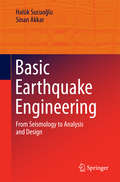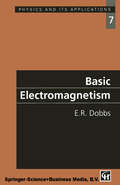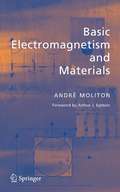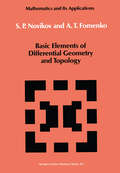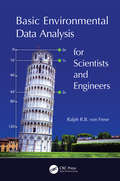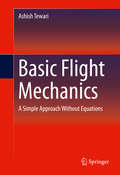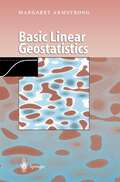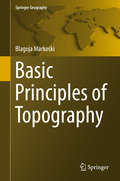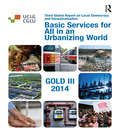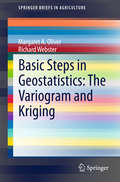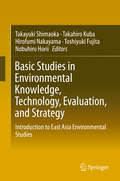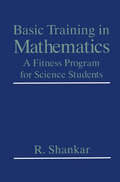- Table View
- List View
Basic Concepts in Computational Physics
by Benjamin A. Stickler Ewald SchachingerThis new edition is a concise introduction to the basic methods of computational physics. Readers will discover the benefits of numerical methods for solving complex mathematical problems and for the direct simulation of physical processes. The book is divided into two main parts: Deterministic methods and stochastic methods in computational physics. Based on concrete problems, the first part discusses numerical differentiation and integration, as well as the treatment of ordinary differential equations. This is extended by a brief introduction to the numerics of partial differential equations. The second part deals with the generation of random numbers, summarizes the basics of stochastics, and subsequently introduces Monte-Carlo (MC) methods. Specific emphasis is on MARKOV chain MC algorithms. The final two chapters discuss data analysis and stochastic optimization. All this is again motivated and augmented by applications from physics. In addition, the book offers a number of appendices to provide the reader with information on topics not discussed in the main text. Numerous problems with worked-out solutions, chapter introductions and summaries, together with a clear and application-oriented style support the reader. Ready to use C++ codes are provided online.
Basic Concepts in Physics: From the Cosmos to Quarks (Undergraduate Lecture Notes in Physics)
by Masud Chaichian Hugo Perez Rojas Anca Tureanu"Basic Concepts in Physics: From the Cosmos to Quarks" is the outcome of the authors' long and varied teaching experience in different countries and for different audiences, and gives an accessible and eminently readable introduction to all the main ideas of modern physics. The book’s fresh approach, using a novel combination of historical and conceptual viewpoints, makes it ideal complementary reading to more standard textbooks. The first five chapters are devoted to classical physics, from planetary motion to special relativity, always keeping in mind its relevance to questions of contemporary interest. The next six chapters deal mainly with newer developments in physics, from quantum theory and general relativity to grand unified theories, and the book concludes by discussing the role of physics in living systems. A basic grounding in mathematics is required of the reader, but technicalities are avoided as far as possible; thus complex calculations are omitted so long as the essential ideas remain clear. The book is addressed to undergraduate and graduate students in physics and will also be appreciated by many professional physicists. It will likewise be of interest to students, researchers and teachers of other natural sciences, as well as to engineers, high-school teachers and the curious general reader, who will come to understand what physics is about and how it describes the different phenomena of Nature. Not only will readers of this book learn much about physics, they will also learn to love it.
Basic Concepts in Physics: From the Cosmos to Quarks (Undergraduate Lecture Notes in Physics)
by Masud Chaichian Anca Tureanu Hugo Perez RojasThis book is the second edition of an excellent undergraduate-level overview of classical and modern physics, intended for students of physics and related subjects, and also perfectly suited for the education of physics teachers. The twelve-chapter book begins with Newton’s laws of motion and subsequently covers topics such as thermodynamics and statistical physics, electrodynamics, special and general relativity, quantum mechanics and cosmology , the standard model and quantum chromodynamics. The writing is lucid, and the theoretical discussions are easy to follow for anyone comfortable with standard mathematics.An important addition in this second edition is a set of exercises and problems, distributed throughout the book. Some of the problems aim to complement the text, others to provide readers with additional useful tools for tackling new or more advanced topics. Furthermore, new topics have been added in several chapters; for example, the discovery of extra-solar planets from the wobble of their mother stars, a discussion of the Landauer principle relating information erasure to an increase of entropy, quantum logic, first order quantum corrections to the ideal gas equation of state due to the Fermi-Dirac and Bose-Einstein statistics. Both gravitational lensing and the time-correction in geo-positioning satellites are explained as theoretical applications of special and general relativity. The discovery of gravitational waves, one of the most important achievements of physical sciences, is presented as well. Professional scientists, teachers, and researchers will also want to have this book on their bookshelves, as it provides an excellent refresher on a wide range of topics and serves as an ideal starting point for expanding one’s knowledge of new or unfamiliar fields. Readers of this book will not only learn much about physics, they will also learn to love it.
Basic Concepts of String Theory (Theoretical and Mathematical Physics)
by Ralph Blumenhagen Dieter Lüst Stefan TheisenThe purpose of this book is to thoroughly prepare the reader for research in string theory at an intermediate level. As such it is not a compendium of results but intended as textbook in the sense that most of the material is organized in a pedagogical and self-contained fashion. Beyond the basics, a number of more advanced topics are introduced, such as conformal field theory, superstrings and string dualities - the text does not cover applications to black hole physics and cosmology, nor strings theory at finite temperatures. End-of-chapter references have been added to guide the reader wishing to pursue further studies or to start research in well-defined topics covered by this book.
Basic Earthquake Engineering: From Seismology to Analysis and Design
by Halûk Sucuoğlu Sinan AkkarThis book provides senior undergraduate students, master students and structural engineers who do not have a background in the field with core knowledge of structural earthquake engineering that will be invaluable in their professional lives. The basics of seismotectonics, including the causes, magnitude, and intensity of earthquakes, are first explained. Then the book introduces basic elements of seismic hazard analysis and presents the concept of a seismic hazard map for use in seismic design. Subsequent chapters cover key aspects of the response analysis of simple systems and building structures to earthquake ground motions, design spectrum, the adoption of seismic analysis procedures in seismic design codes, seismic design principles and seismic design of reinforced concrete structures. Helpful worked examples on seismic analysis of linear, nonlinear and base isolated buildings, earthquake-resistant design of frame and frame-shear wall systems are included, most of which can be solved using a hand calculator.
Basic Electromagnetism (Physics and Its Applications)
by E.R. DobbsProfessor Dobbs provides an elegant and clear account of the subject, leading the student from electrostatics through to Maxwell's equations and electromagnetic waves, covering all the material needed by a student taking courses on electricity and magnetism and electromagnetic waves.
Basic Electromagnetism and Materials
by André MolitonThis textbook can be used to teach electromagnetism to a wide range of undergraduate science majors in physics, electrical engineering or materials science. By making lesser demands on mathematical knowledge than typical texts, and by emphasizing electromagnetic properties of materials and their applications, this text is particularly appropriate for students of materials science. Many competing books focus on the study of propagation waves either in the microwave or optical domain, whereas Basic Electromagnetism and Materials covers the entire electromagnetic domain and the physical response of materials to these waves.
Basic Elements of Differential Geometry and Topology (Mathematics and its Applications #60)
by S.P. Novikov A.T. FomenkoBasic Environmental Data Analysis for Scientists and Engineers
by Ralph R.B. Von FreseClassroom tested and the result of over 30 years of teaching and research, this textbook is an invaluable tool for undergraduate and graduate data analysis courses in environmental sciences and engineering. It is also a useful reference on modern digital data analysis for the extensive and growing community of Earth scientists and engineers. Basic Environmental Data Analysis for Scientists and Engineers introduces practical concepts of modern digital data analysis and graphics, including numerical/graphical calculus, measurement units and dimensional analysis, error propagation and statistics, and least squares data modeling. It emphasizes array-based or matrix inversion and spectral analysis using the fast Fourier transform (FFT) that dominates modern data analysis. Divided into two parts, this comprehensive hands-on textbook is excellent for exploring data analysis principles and practice using MATLAB®, Mathematica, Mathcad, and other modern equation solving software. Part I, for beginning undergraduate students, introduces the basic approaches for quantifying data variations in terms of environmental parameters. These approaches emphasize uses of the data array or matrix, which is the fundamental data and mathematical processing format of modern electronic computing. Part II, for advanced undergraduate and beginning graduate students, extends the inverse problem to least squares solutions involving more than two unknowns. Features: Offers a uniquely practical guide for making students proficient in modern electronic data analysis and graphics Includes topics that are not explained in any existing textbook on environmental data analysis Data analysis topics are very well organized into a two-semester course that meets general education curriculum requirements in science and engineering Facilitates learning by beginning each chapter with an ‘Overview’ section highlighting the topics covered, and ending it with a ‘Key Concepts’ section summarizing the main technical details that the reader should have acquired Indexes many numerical examples for ready access in the classroom or other venues serviced by electronic equation solvers like MATLAB®, Mathematica, Mathcad, etc. Offers supplemental exercises and materials to enhance understanding the principles and practice of modern data analysis
Basic Environmental Data Analysis for Scientists and Engineers
by Ralph R.B. Von FreseClassroom tested and the result of over 30 years of teaching and research, this textbook is an invaluable tool for undergraduate and graduate data analysis courses in environmental sciences and engineering. It is also a useful reference on modern digital data analysis for the extensive and growing community of Earth scientists and engineers. Basic Environmental Data Analysis for Scientists and Engineers introduces practical concepts of modern digital data analysis and graphics, including numerical/graphical calculus, measurement units and dimensional analysis, error propagation and statistics, and least squares data modeling. It emphasizes array-based or matrix inversion and spectral analysis using the fast Fourier transform (FFT) that dominates modern data analysis. Divided into two parts, this comprehensive hands-on textbook is excellent for exploring data analysis principles and practice using MATLAB®, Mathematica, Mathcad, and other modern equation solving software. Part I, for beginning undergraduate students, introduces the basic approaches for quantifying data variations in terms of environmental parameters. These approaches emphasize uses of the data array or matrix, which is the fundamental data and mathematical processing format of modern electronic computing. Part II, for advanced undergraduate and beginning graduate students, extends the inverse problem to least squares solutions involving more than two unknowns. Features: Offers a uniquely practical guide for making students proficient in modern electronic data analysis and graphics Includes topics that are not explained in any existing textbook on environmental data analysis Data analysis topics are very well organized into a two-semester course that meets general education curriculum requirements in science and engineering Facilitates learning by beginning each chapter with an ‘Overview’ section highlighting the topics covered, and ending it with a ‘Key Concepts’ section summarizing the main technical details that the reader should have acquired Indexes many numerical examples for ready access in the classroom or other venues serviced by electronic equation solvers like MATLAB®, Mathematica, Mathcad, etc. Offers supplemental exercises and materials to enhance understanding the principles and practice of modern data analysis
Basic Flight Mechanics: A Simple Approach Without Equations
by Ashish TewariThis book presents flight mechanics of aircraft, spacecraft, and rockets to technical and non-technical readers in simple terms and based purely on physical principles. Adapting an accessible and lucid writing style, the book retains the scientific authority and conceptual substance of an engineering textbook without requiring a background in physics or engineering mathematics. Professor Tewari explains relevant physical principles of flight by straightforward examples and meticulous diagrams and figures. Important aspects of both atmospheric and space flight mechanics are covered, including performance, stability and control, aeroelasticity, orbital mechanics, and altitude control. The book describes airplanes, gliders, rotary wing and flapping wing flight vehicles, rockets, and spacecraft and visualizes the essential principles using detailed illustration. It is an ideal resource for managers and technicians in the aerospace industry without engineering degrees, pilots, and anyone interested in the mechanics of flight.
Basic Geological Mapping (Geological Field Guide #35)
by John W. Barnes Richard J. LisleDesigned to be carried in the field, this pocket-sized how-to book is a practical guide to basic techniques in mapping geological structures. In addition to including the latest computerised developments, the author provides succinct information on drawing cross-sections and preparing and presenting 'fair copy' maps and geological diagrams. Contains a brief chapter on the essentials of report writing and discusses how to keep adequate field notebooks. A checklist of equipment needed in the field can be found in the appendices. Quote from 3rd edition "provides a wealth of good advice on how to measure, record and write reports of geological field observations" The Naturalist
Basic Geological Mapping
by John W. Barnes Richard J. LisleDesigned to be carried in the field, this pocket-sized how-to book is a practical guide to basic techniques in mapping geological structures. In addition to including the latest computerised developments, the author provides succinct information on drawing cross-sections and preparing and presenting 'fair copy' maps and geological diagrams. Contains a brief chapter on the essentials of report writing and discusses how to keep adequate field notebooks. A checklist of equipment needed in the field can be found in the appendices. Quote from 3rd edition "provides a wealth of good advice on how to measure, record and write reports of geological field observations" The Naturalist
Basic Geological Mapping (Geological Field Guide #42)
by Richard J. Lisle Peter Brabham John W. BarnesPart of The Geological Field Guide Series, Basic Geological Mapping, 5th Edition is an essential basic guide to field techniques in mapping geology. Now completely revised and updated the book retains the concise clarity which has made it an indispensable instant reference in its previous editions. It provides the reader with all the necessary practical information and techniques that they will need while carrying out work in the field, covering a wide spectrum of different conditions, needs and types of countries. This edition covers new developments in technology including Google Earth and the use of GPS. This is an ideal field guide to geological mapping for 2nd/3rd year undergraduates of Geology, Hydrogeology and Geological Engineering.
Basic Geological Mapping (Geological Field Guide #34)
by Richard J. Lisle Peter Brabham John W. BarnesPart of The Geological Field Guide Series, Basic Geological Mapping, 5th Edition is an essential basic guide to field techniques in mapping geology. Now completely revised and updated the book retains the concise clarity which has made it an indispensable instant reference in its previous editions. It provides the reader with all the necessary practical information and techniques that they will need while carrying out work in the field, covering a wide spectrum of different conditions, needs and types of countries. This edition covers new developments in technology including Google Earth and the use of GPS. This is an ideal field guide to geological mapping for 2nd/3rd year undergraduates of Geology, Hydrogeology and Geological Engineering.
Basic Linear Geostatistics
by Margaret ArmstrongBased on a postgraduate course that has been successfully taught for over 15 years, the underlying philosophy here is to give students an in-depth understanding of the relevant theory and how to put it into practice. This involves going into the theory in more detail than most books do, and also discussing its applications. It is assumed that readers, students and professionals alike are familiar with basic probability and statistics, as well as the matrix algebra needed for solving linear systems; however, some reminders on these are given in an appendix. Exercises are integrated throughout, and the appendix contains a review of the material.
Basic Offshore Safety: Safety induction and emergency training for new entrants to the offshore oil and gas industry
by Abdul KhaliqueComprehensive insight into the offshore oil and gas industry for those intending to choose it as a career Full syllabus coverage for OPITO BOSIET, FOET, MIST and IMIST courses Produced in full colour with over 180 images Basic Offshore Safety covers everything that newcomers to the offshore oil and gas industry need to know ?prior to travelling offshore or when attending OPITO's Basic Offshore Safety Induction and Emergency Training (BOSIET), Minimum Industry Safety Training (MIST), Further Offshore Emergency Training (FOET) and International MIST courses. Primarily focused on the oil industry, this book introduces readers to the key safety topics in the offshore support vessel industry and common to the renewable industry. Written in easy to follow steps and including references to both the legislation and guidance where relevant, Abdul Khalique walks the reader through the hazards they are likely to encounter when travelling to, from or working offshore, showing how to minimise risks and deal with any issues that may arise at any stage of the work.
Basic Offshore Safety: Safety induction and emergency training for new entrants to the offshore oil and gas industry
by Abdul KhaliqueComprehensive insight into the offshore oil and gas industry for those intending to choose it as a career Full syllabus coverage for OPITO BOSIET, FOET, MIST and IMIST courses Produced in full colour with over 180 images Basic Offshore Safety covers everything that newcomers to the offshore oil and gas industry need to know ?prior to travelling offshore or when attending OPITO's Basic Offshore Safety Induction and Emergency Training (BOSIET), Minimum Industry Safety Training (MIST), Further Offshore Emergency Training (FOET) and International MIST courses. Primarily focused on the oil industry, this book introduces readers to the key safety topics in the offshore support vessel industry and common to the renewable industry. Written in easy to follow steps and including references to both the legislation and guidance where relevant, Abdul Khalique walks the reader through the hazards they are likely to encounter when travelling to, from or working offshore, showing how to minimise risks and deal with any issues that may arise at any stage of the work.
Basic Principles of Topography (Springer Geography)
by Blagoja MarkoskiThis book gives a comprehensive overview of all relevant elements in topography and their practical application. It elaborates on the classical representation of terrain on maps such as cartographic projections, together with their classification, scale, and geographical elements. It is richly illustrated with photographs, maps and figures, in which the theoretical explanations are clarified.Readers will become acquainted with the physical characteristics of the ground, i.e. tectonic and erosive shapes, the importance and classification of terrain, genetic (fluvial, abrasive, glacial, karst) and topographic types such as higher (mountains, hills, peaks) and lower terrain (valleys, fields). In addition, the book discusses cartometry and coordinate systems, orientation in space (geographic, topographic, tactical) including by means of maps, instruments and the night sky and elaborates new techniques and technologies such as aerial photogrammetric imagery, global navigation satellite systems and LiDAR. The book also includes methods for the practical execution of concrete measurement operations, such as determining position and movement on land with maps, compass and azimuth which makes it especially useful for practitioners and professionals, e.g., for landscape planning, military exercises, mountaineering, nature walks etc. As such it offers a valuable guide not only for undergraduate students but also for researchers in the fields of geography, geosciences, geodesy, ecology, forestry and related areas looking for an overview on topography. Uniquely, the book also features an extensive glossary of topographical terms.
Basic Relativity: An Introductory Essay (SpringerBriefs in Physics)
by Péter HraskóThis Brief presents a new way of introducing relativity theory, in which perplexing relativistic effects such as time dilation and Lorentz contraction are explained prior to the discussion of Lorentz-transformation. The notion of relativistic mass is shown to contradict the spirit of relativity theory and the true significance of the mass-energy relation is contrasted with the popular view of it. The author discusses the twin paradox from the point of view of both siblings. Last but not least, the fundamentals of general relativity are described, including the recent Gravity Probe B experiment.
Basic Services for All in an Urbanizing World
by United Cities And Local Governments StaffUCLG’s Third Global Report on Local Democracy and Decentralization (GOLD III) examines basic service provision and the current state-of-play of the local governance of basic services around the world. Basic Services for All in an Urbanizing World examines the enormous challenge of ensuring the universal provision of basic services in a world that is being shaped by rapid global urbanization, climate change, and economic, social and technological transformation. The world’s urban population is predicted to reach 5 billion people within the next 20-30 years. The report analyses the conditions necessary for local governments to provide these new urban residents with quality basic services. Water, sanitation, waste management, transport and energy are essential, not only for the preservation of human life and dignity, but also in driving economic growth and ensuring social equality. Each chapter examines a world region, drawing on existing research and consultation with local authorities on the ground. The chapters review access levels, legal and institutional frameworks, and the different ways in which basic services are managed and financed, as well as showcasing diverse examples of innovation in the local and multi-level governance of services. It concludes with a set of recommendations for all stakeholders with a view to making the goal of basic services for all a reality. This report contributes to discussions on the Millennium Development Goals and the UN Post-2015 Development Agenda. The findings of GOLD III will also be essential to promoting the vision of local governments at the 2016 UN Conference on Human Settlements (Habitat III).
Basic Services for All in an Urbanizing World
by UclgUCLG’s Third Global Report on Local Democracy and Decentralization (GOLD III) examines basic service provision and the current state-of-play of the local governance of basic services around the world. Basic Services for All in an Urbanizing World examines the enormous challenge of ensuring the universal provision of basic services in a world that is being shaped by rapid global urbanization, climate change, and economic, social and technological transformation. The world’s urban population is predicted to reach 5 billion people within the next 20-30 years. The report analyses the conditions necessary for local governments to provide these new urban residents with quality basic services. Water, sanitation, waste management, transport and energy are essential, not only for the preservation of human life and dignity, but also in driving economic growth and ensuring social equality. Each chapter examines a world region, drawing on existing research and consultation with local authorities on the ground. The chapters review access levels, legal and institutional frameworks, and the different ways in which basic services are managed and financed, as well as showcasing diverse examples of innovation in the local and multi-level governance of services. It concludes with a set of recommendations for all stakeholders with a view to making the goal of basic services for all a reality. This report contributes to discussions on the Millennium Development Goals and the UN Post-2015 Development Agenda. The findings of GOLD III will also be essential to promoting the vision of local governments at the 2016 UN Conference on Human Settlements (Habitat III).
Basic Steps in Geostatistics: The Variogram and Kriging (SpringerBriefs in Agriculture)
by Margaret A. Oliver Richard WebsterThis brief will provide a bridge in succinct form between the geostatistics textbooks and the computer manuals for `push-button' practice. It is becoming increasingly important for practitioners, especially neophytes, to understand what underlies modern geostatistics and the currently available software so that they can choose sensibly and draw correct conclusions from their analysis and mapping. The brief will contain some theory, but only that needed for practitioners to understand the essential steps in analyses. It will guide readers sequentially through the stages of properly designed sampling, exploratory data analysis, variography (computing the variogram and modelling it), followed by ordinary kriging and finally mapping kriged estimates and their errors. There will be short section on trend and universal kriging. Other types of kriging will be mentioned so that readers can delve further in the substantive literature to tackle more complex tasks.
Basic Studies in Environmental Knowledge, Technology, Evaluation, and Strategy: Introduction to East Asia Environmental Studies
by Takayuki Shimaoka Takahiro Kuba Hirofumi Nakayama Toshiyuki Fujita Nobuhiro HoriiThis book covers diverse environmental issues such as climate change; biodiversity preservation; prevention of air, water, and soil pollution; and resource recycling. Readers can acquire these four practical interdisciplinary abilities: 1. knowledge; 2. technology; 3. evaluation; and 4. strategy in the diverse issues related to the environment. These abilities are fundamental to identifying the core essence of economic and ecological interdependence, to look at and analyze problems from an overarching perspective, and to consider countermeasures to be taken. Each chapter of this book corresponds to a lecture in the East Asia Environmental Strategist Training Program at Kyushu University and is excellent reading as a sourcebook.
Basic Training in Mathematics: A Fitness Program for Science Students
by R. ShankarBased on course material used by the author at Yale University, this practical text addresses the widening gap found between the mathematics required for upper-level courses in the physical sciences and the knowledge of incoming students. This superb book offers students an excellent opportunity to strengthen their mathematical skills by solving various problems in differential calculus. By covering material in its simplest form, students can look forward to a smooth entry into any course in the physical sciences.
